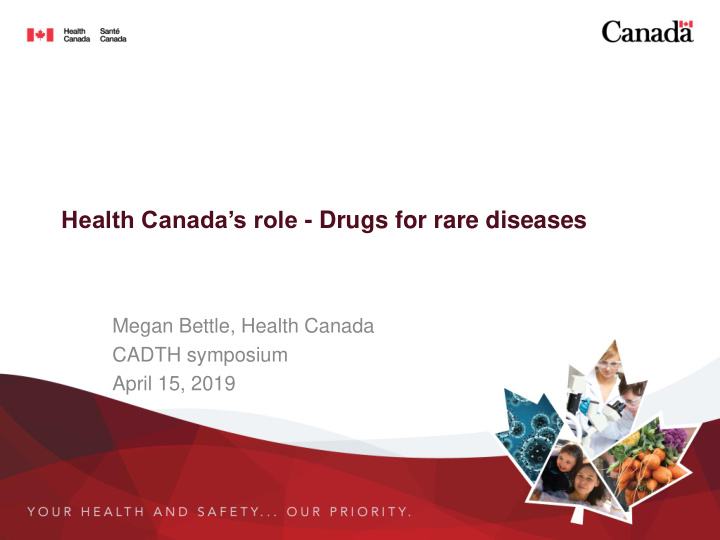



Health Canada’s role - Drugs for rare diseases Megan Bettle, Health Canada CADTH symposium April 15, 2019
Challenges – Drugs for Rare Disease Development and Patient Access Challenging to Technical challenges (e.g. lack of basic science, small patient populations, need develop: for non-standard trials) Regulatory challenges (e.g. different international approaches) Regulation of companion diagnostics Business challenges (e.g. range in profitability may be significant for small populations, some lack business incentive to develop) Once developed Can be costly and may be difficult to implement, especially outside of specialist and authorized centres. for market: May be inequitable access - public and private drug plans may make different reimbursement decisions; funding recommendations may have smaller scope than HC-authorized indications based on cost-effectiveness assessment 2
Health Canada as Regulator • Under the Food and Drugs Act , Health Canada regulates, evaluates and monitors the safety, efficacy, and quality of therapeutic products • Includes product oversight at all stages of life cycle, from early testing in clinical trials, to post- market surveillance of adverse drug reactions, and compliance monitoring 3
Drug Submission Review • Sponsors must provide sufficient evidence of the product's safety, efficacy and quality for assessment, including – Manufacturing details and controls to ensure consistent quality – Pre-clinical data to establish safety – Clinical data to support proposed indication, including “substantial evidence of effectiveness” – Proposed labels – claims, instructions for use – Assessment of possibility for name confusion • Health Canada then reviews the evidence and decides whether the benefits of the product outweigh the risks, and whether the risks can be managed • Health Canada continues to receive supplementary submissions after first Notice of Compliance granted, for any significant change, including: – New indications – Manufacturing changes • ~ 30% of the new drugs authorized in 2018 are considered orphan drugs in other jurisdictions 4
Pathways to Drug Access Regulatory authorization: New Drug Submission/Supplementary New Drug Submission – review for safety, quality efficacy • Target review time – 300 days [similar review for generics = 180 days] Priority review policy • Unmet medical need, serious, life-threatening or severely debilitating disease • Requirement for “substantial” evidence of effectiveness • Target review time – 180 days [In 2018, 4 drugs for rare diseases were reviewed under this pathway] Notice of Compliance with Conditions policy • Unmet medical need, serious, life-threatening or severely debilitating disease • “Promising” evidence of effectiveness • Target review time – 200 days [In 2018, 1 drug for a rare disease was reviewed under this pathway] • Manufacturer agrees to conduct confirmatory studies Other Access: Special Access Programme • Access to drugs which are not authorized in Canada, when other treatments exhausted or not possible • Initiated by prescriber for individual patients 5
Post-market Monitoring and Surveillance • Once a product has been marketed in Canada, there are ongoing obligations for sponsors, including: – Reporting of adverse drug reactions (ADRs) – Preparing annual summary reports on safety – Managing any changes in the benefit-risk profile • Health Canada conducts ongoing analysis of ADRs, environmental scanning, ongoing assessment of potential safety issues – As needed, issues risk communications to inform Canadians and prescribers of changes – Updates product labelling to ensure accuracy and to support safe use – If benefit-risk no longer favourable, products can be withdrawn from market – Relies on many sources of data, including clinical trials, individual case reports, and real world evidence 6
Transforming how we regulate Objective: An agile regulatory system that supports better access to therapeutic products based on healthcare system needs Expanded collaboration with More timely access to drugs and health partners devices • Alignment of the Health • Expansion of Priority Review Enhanced use of real world Technology Assessment Pathways evidence • Improving Access to Biosimilars (CADTH) Review with Health Canada Review and Biologics • Leveraging Data for • Improving Access to Generic Drugs Assessing Drug Safety and • Implementing a Mechanism for • Building Better Access to Digital Effectiveness Early Parallel Scientific Advice Health Technologies • Pre-Submission Scientific Advice • Strengthening the use of • Use of Foreign for Medical Devices real world evidence and • Special Access Programme (SAP) Reviews/Decisions regulations for medical Renewal and Block Release devices • International Collaboration and Work Sharing in Reviews Modern and flexible operations Updated System Infrastructure Appropriate cost recovery framework Public Release of Clinical Information 7
R2D2 – Some Accomplishments to Date Expanded collaboration Established mechanisms for aligned regulatory and health technology assessment reviews, with potential to save overall time to market 19 aligned reviews completed, 9 ongoing, ~75% are new drugs Created processes to share submission review with other regulators 2 reviews completed, more ongoing (partnering with Australia) More timely availability of drugs and devices Draft guidance document describing revised criteria for accelerated review, which can include drugs for rare diseases Ongoing operational updates to the Special Access Program to reduce burden on prescribers Expanded Use of Real World Evidence Providing guidance on quality of evidence needed to support regulatory decision-making and encouraging submissions using RWE Modern and Flexible Operations Final publication of regulations supporting release of clinical information from drug submissions 8
What’s Next? Interim report on implementation of national pharmacare: “ The Council also recognizes the unique challenges of funding and accessing expensive drugs for rare diseases. Special consideration is needed to determine how to address these challenges to ensure a nationally consistent approach for these medications .” Budget 2019 commitments: • Creation of a “Canadian drug agency” - assessment, pricing negotiation, national formulary • National strategy for EDRDs – up to $1B over 2 years in 2022-23, $500M ongoing Creating flexibility in the regulatory system to support innovation in bio-sciences: • Budget Implementation Act includes new pathway for “advanced therapeutic products” – Creation of “regulatory sandboxes” to support innovative products that don’t fit well into existing regulatory frameworks • Modernizing clinical trial regulation – To become more risk-based and agile 9
Recommend
More recommend